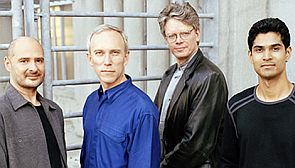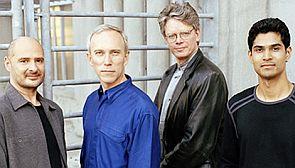
Photo by Jay Blakesberg
Yet the Kronos Quartet has long shown that new music can be fun as well as challenging, beautiful while radical, accessible and interesting at the same time. The San Francisco–based ensemble brings diversity, technology, tradition, and artistic awareness to new music. Its members show that the string quartet can continue to be the serious artistic endeavor that it has always been, while also managing to become cutting edge and fresh — that new music can pack concert halls, as it did Sunday evening at UC Berkeley's Hertz Hall.
Less and less new music is academically atonal or fanatically minimalistic. The new music in this recital was influenced by popular culture, technology, and current events. It was also influenced by successful commercial genres, yet is developed and complex. This is not your grandparents' abstract modernism; rather, it is postmodernism defined.
Opening the program was the West Coast premiere of Russian-Israeli composer Aviya Kopelman's Widows and Lovers (2007). Kopelman is the winner of the Quartet's "Under 30" project, which, as first violinist David Harrington explained in a postconcert lecture, was a way for the Quartet to get in touch with the current hip musical scene as its veteran members age into their 60s.
Kopelman cites the electronica world and Radiohead, in addition to Schnittke and Shostakovich, as influences. Her piece blends electronic manipulation and sampling "without forsaking the strings' ... warm, living, breathing, deeply expressive sound." During rehearsals, she commented that one of the violinists "sounds like a MIDI synthesizer." Naturally, he was initially offended, but was then surprised to learn that she meant it as a compliment. For her, the electronic sound world is a natural mode of expression, whereas the string quartet is the novelty — she probably feels musically at home in a dance club, as well as in a concert hall.
Attempts at fusion of various genres are often made, but rare is the intrinsic understanding of both worlds that Kopelman has achieved. This explains the fresh approach and unconventional soundscape she was able to produce. It also explains the lack of contrapuntal string writing and idiomatic dialogue usually heard in the standard repertoire for string quartet.
Deadly Drama
Widows and Lovers takes its inspiration from a type of marijuana and a poisonous spider. It featured the Kronos members walking on stage to the recorded sound of audience cheers at a rock concert. Acknowledging drug use is matter-of-fact for Kopelman, and she cites its inhibition-canceling influences. The drama progresses from the fun and exciting, through the mysterious, to the dark and deadly — a progression backward from the typical course of conflict resolution.The piece conjures an array of unusual sound, though the core quartet sound is always at hand — a fascinating mix. The production of the piece required computer programming expertise by Roy Yarkoni on the composer's end, as well as the technical wizardry of sound designer Scott Fraser and lighting designer Laurence Neff. The commission of this piece was made possible by a conglomeration of granting organizations, including Cal Performances, which presented this concert.
The next two pieces on the program matched the first piece's approach: a considerate mix of electronic and acoustic sound. Scandinavian composer Kaija Saariaho's Nymphéa (1987) creates a soundscape to revel in: a journey through sonic adventures. Listening to it is a completely different experience from listening to regular music; it's more than a different language, it's a different way of thinking about what goes into your ears. Polish composer Hanna Kulenty's String Quartet No. 4 (2007) is the third iteration of a cradle song she originally composed for her newborn baby. After the child died at the age of 10, she reset that melody in what must have been a heartbreaking variation. For this latest installment, the composer claims in the program notes to have achieved a positive reacceptance of this song. It's a sweet story, but as a listener, it would have been nice to know what that song was — I was never quite sure.
Conversations Among Women Composers
It was only when I was hearing the last piece that I realized that all composers on the concert were women. The performance certainly wasn't advertised as such, and that was clearly not the sole motivating factor in programming. Another factor was that all the pieces on the first half of the program conversed with each other — they had a similarly intense and difficultly passionate approach. About 50 of the 650-plus works commissioned by the Kronos are by women composers. This is a much higher proportion than is found elsewhere in the classical music world, though as Harrington pointed out, assuming gender equality and lack of barriers, it should be half-and-half.Following intermission, Aleksandra Vrebaov's ...hold me, neighbor, in this storm... (2007) was the most recognizably tonal work on the program, but still far from anything listeners usually hear at a string quartet concert. Making up for the "sin" of easily discernible melodies, Vrebaov employs percussion instruments played by the quartet, an ethnic Balkan string instrument known as the gusle (played most convincingly by Harrington), extended techniques such as fingerboard slaps, and intimations of war noises. The piece juxtaposed a European section with a Middle Eastern section, separated by gunshot-like attacks. The meaning was clear to the listener, almost to the point of being obvious. The composition presented an ideal mix of contemporary style, traditional musical beauty in the folk tunes, enjoyable danceability, and novelty, along with a powerful message.
For encores, two more short excerpts by women composers, were presented. They were quartet arrangements of popular music: Greek singer Marika Papagika’s Smyrneiko Minore, and Tabu by Cuban artist Margarita Lecuona. The Kronos Quartet is a class act. Its mission is admirable, its openness exemplary. Its concerts provide so much to write about that sometimes the members' instrumental skills are forgotten. David Harrington's leadership is clear, while violinists John Sherba and Hank Dutt provide rhythmic precision and hugely varied timbres in support. But that isn't to say that they don't grab the spotlight when the composer turns one on. Dutt's raspy solo in hold me, neighbor was gripping yet tender, and was multiplied in both qualities when joined by Sherba. Jeffrey Zeigler joined the group in 2005 and already fits in naturally, though the age difference next to his colleagues is stark. Still, like the mission of the "Under 30" project, he represents a link to the current, in contrast to the link to the past that is the mission of so many "classical music ensembles" — whatever that means.

